Assessments
Dr. Parlee is certified to administer all of the following assessments:
The Leadership Circle 360 Feedback Assessment:
The Leadership Circle Profile is designed to accelerate leadership effectiveness beyond traditional competency-based approaches. When it comes to developing leaders, training to competencies alone does not work very well. For more rapid and lasting results, it is crucial that organizations help leaders gain deeper insight into their behavior and what is driving it. The Leadership Circle Profile™ is the only 360 degree competency assessment that simultaneously provides focused competency feedback while revealing the underlying assumptions that are causing a leader’s pattern of strengths and limitations. The Leadership Circle Profile helps leaders understand the relationship between how they habitually think, how they behave, and, more importantly, how all this impacts their current level of leadership effectiveness. Once this awareness is established, leadership development can proceed. Without it, change rarely happens.
While most 360 degree assessments tell you only what is or is not contributing to a leader’s effectiveness, the Leadership Circle Profile also tells you “why” this is so. It gives the leader causational insight into what is happening beneath the surface. This powerful difference puts The Leadership Circle Profile in a class of its own. The Leadership Circle Profile is the only 360 degree profile that measures both competency and underlying assumptions and it does so in two primary leadership domains: Creative Competencies and Reactive Tendencies.

Two Dimensions of Leadership
Creative competencies are well-researched competencies that measure how leaders achieve results, bring out the best in others, lead with vision, enhance your own development, act with integrity, and encourage and improve organizational systems.
Reactive tendencies are leadership styles that emphasize caution over creating results, self-protection over productive engagement, and aggression over building alignment. These self-limiting styles overemphasize the focus on gaining the approval of others, protecting oneself, and getting results through high control tactics.
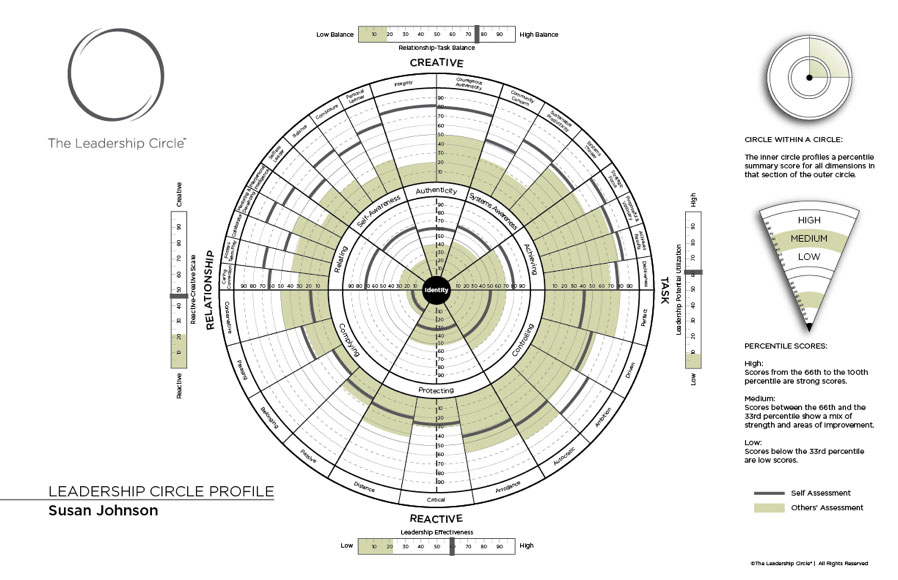
Then, the Leadership Circle Profile integrates this information so that key opportunities for development immediately rise to the surface. Most importantly, the Leadership Circle Profile is unique because it reveals a leader’s operating system–the internal assumptions or beliefs that guide behavior in both domains. This system allows managers to see how their inner world translates into a effective or ineffective leadership. Using this approach increases the inner awareness that correspondingly affects outward behavior.
The Leadership Development Profile
“Leaders are made, not born, and how they develop is critical for organizational change.”
Most developmental psychologists now agree that what differentiates leaders is not so much their philosophy of leadership, their personality, or their style of management, but rather it’s their internal worldview or ‘Action Logic’ – how they construct reality and respond to emerging situations, and plan for the future.
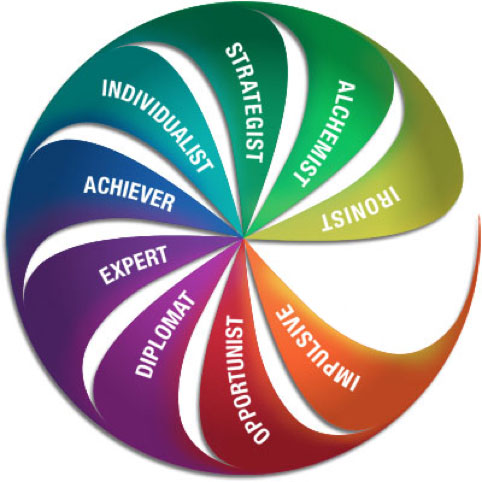
Action Logics
Each leader is informed by a dominant Action Logic which has been shaped by time, experience and learning. A leader’s Action Logic both enables and constrains effectiveness, interacting with the demands made on the leader. Most leaders, however, are not conscious of their Action Logic and thus are ‘blind’ to it. They are unaware they can transform beyond the limits of their current ways of thinking and acting.
Becoming aware of their Action Logic provides leaders with crucial insights into what constrains their effectiveness and importantly, how they can develop beyond these constraints.
The dominant Action Logic of a team, a division or a whole organization has a dramatic impact on its performance and ability. The challenge for most organizations is to move beyond the ‘Achiever’ frame to incorporate ‘Strategist’ thinking and behavior (see the table of Action Logics and read the Harvard Business Review article Seven Transformations of Leadership to understand more about ‘Achievers’ and ‘Strategists’).
Developing Transformational Intelligence
Through extensive engagements with clients, Harthill supports the development of transformational intelligence in leaders and organizations. Transformational intelligence is a collection of capabilities found in ‘Individualists’, ‘Strategists’ and ‘Alchemists.’
However, these capabilities are available to anyone who takes on certain practices. By inquiring into and experimenting with particular capabilities it is possible to encourage radical development – extending the strengths of any Action Logic.
Leaders who undertake a voyage of inquiry and personal development can transform their own capabilities and those of their organizations. Corporations that help their executives and leadership teams develop rich rewards reap rich rewards.
MBTI: Myers Briggs Type Indicator
The purpose of the Myers-Briggs Type Indicator® (MBTI®) personality inventory is to make the theory of psychological types described by C. G. Jung understandable and useful in people’s lives. The essence of the theory is that much seemingly random variation in the behavior is actually quite orderly and consistent, being due to basic differences in the ways individuals prefer to use their perception and judgment.
“Perception involves all the ways of becoming aware of things, people, happenings, or ideas. Judgment involves all the ways of coming to conclusions about what has been perceived. If people differ systematically in what they perceive and in how they reach conclusions, then it is only reasonable for them to differ correspondingly in their interests, reactions, values, motivations, and skills.”
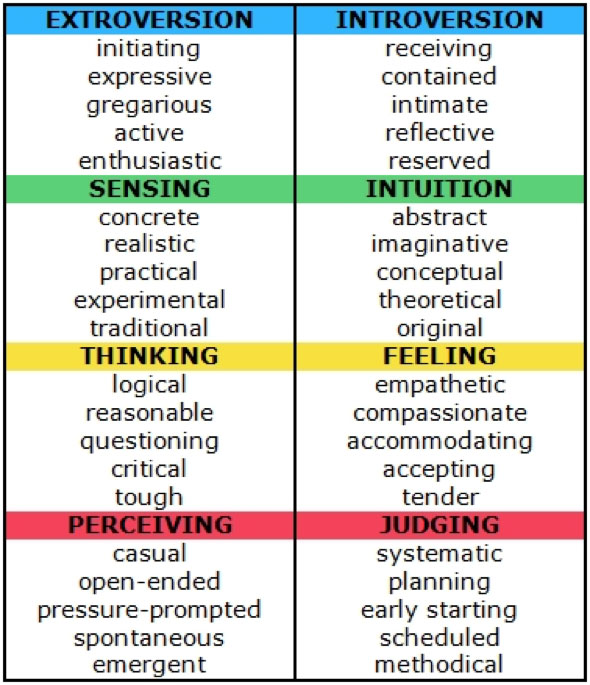
In developing the Myers-Briggs Type Indicator [instrument], the aim of Isabel Briggs Myers, and her mother, Katharine Briggs, was to make the insights of type theory accessible to individuals and groups. They addressed the two related goals in the developments and application of the MBTI instrument:
The identification of basic preferences of each of the four dichotomies specified or implicit in Jung’s theory.
The identification and description of the 16 distinctive personality types that result from the interactions among the preferences.”
Excerpted with permission from the MBTI® Manual: A Guide to the Development and Use of the Myers-Briggs Type Indicator®
Favorite world: Do you prefer to focus on the outer world or on your own inner world? This is called Extraversion (E) or Introversion (I).
Information: Do you prefer to focus on the basic information you take in or do you prefer to interpret and add meaning? This is called Sensing (S) or Intuition (N).
Decisions: When making decisions, do you prefer to first look at logic and consistency or first look at the people and special circumstances? This is called Thinking (T) or Feeling (F).
Structure: In dealing with the outside world, do you prefer to get things decided or do you prefer to stay open to new information and options? This is called Judging (J) or Perceiving (P).
Your Personality Type: When you decide on your preference in each category, you have your own personality type, which can be expressed as a code with four letters.
The 16 personality types of the Myers-Briggs Type Indicator® instrument are listed here as they are often shown in what is called a “type table.”
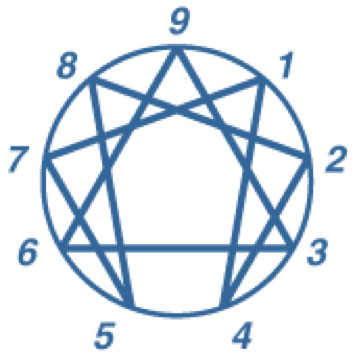
Your Basic Personality Type:
From one point of view, the Enneagram can be seen as a set of nine distinct personality types, with each number on the Enneagram denoting one type. It is common to find a little of yourself in all nine of the types, although one of them should stand out as being closest to yourself. This is your basic personality type.
Your Basic Personality Type:
From one point of view, the Enneagram can be seen as a set of nine distinct personality types, with each number on the Enneagram denoting one type. It is common to find a little of yourself in all nine of the types, although one of them should stand out as being closest to yourself. This is your basic personality type.

Everyone emerges from childhood with one of the nine types dominating their personality, with inborn temperament and other pre-natal factors being the main determinants of our type. This is one area where most all of the major Enneagram authors agree—we are born with a dominant type. Subsequently, this inborn orientation largely determines the ways in which we learn to adapt to our early childhood environment. It also seems to lead to certain unconscious orientations toward our parental figures, but why this is so, we still do not know. In any case, by the time children are four or five years old, their consciousness has developed sufficiently to have a separate sense of self. Although their identity is still very fluid, at this age children begin to establish themselves and find ways of fitting into the world on their own.
Thus, the overall orientation of our personality reflects the totality of all childhood factors (including genetics) that influenced its development.
Several more points can be made about the basic type itself.
- People do not change from one basic personality type to another.
- The descriptions of the personality types are universal and apply equally to males and females, since no type is inherently masculine or feminine.
- Not everything in the description of your basic type will apply to you all the time because you fluctuate constantly among the healthy, average, and unhealthy traits that make up your personality type.
- The Enneagram uses numbers to designate each of the types because numbers are value neutral— they imply the whole range of attitudes and behaviors of each type without specifying anything either positive or negative. Unlike the labels used in psychiatry, numbers provide an unbiased, shorthand way of indicating a lot about a person without being pejorative.
- The numerical ranking of the types is not significant. A larger number is no better than a smaller number; it is not better to be a Nine than a Two because nine is a bigger number.
- No type is inherently better or worse than any other. While all the personality types have unique assets and liabilities, some types are often more desirable than others in any given culture or group. Furthermore, for one reason or another, you may not be happy being a particular type. You may feel that your type is “handicapped” in some way. As you learn more about all the types, you will see that just as each has unique capacities, each has different limitations. If some types are more esteemed in Western society than others, it is because of the qualities that society rewards, not because of any superior value of those types. The ideal is to become your best self, not to imitate the assets of another type.
As you think about your personality, which of the following nine roles fits you best most of the time? Or, to put it differently, if you were to describe yourself in a few words, which of the following word clusters would come closest?
Type One is principled, purposeful, self-controlled, and perfectionistic.
Type Two is generous, demonstrative, people-pleasing, and possessive.
Type Three is adaptable, excelling, driven, and image-conscious.
Type Four is expressive, dramatic, self-absorbed, and temperamental.
Type Five is perceptive, innovative, secretive, and isolated.
Type Six is engaging, responsible, anxious, and suspicious.
Type Seven is spontaneous, versatile, acquisitive, and scattered.
Type Eight is self-confident, decisive, willful, and confrontational.
Type Nine is receptive, reassuring, complacent, and resigned.

LEADERSHIP TRAINING AND CONSULTATION
Corporate Values, Purpose and Guiding Principles:
Who are You, and Why are you Here?
Understanding the codes that define you, the reason for which you exist, and the guiding principles that will allow you to manifest your destiny are powerful markers in service of your success. Do you know what your purpose is? Have you reflected on, and articulated the central core values that are your guiding light; the principles that define your action? Is your leadership team clear and aligned on these “meaning” dimensions that move and inspire your work together? Is there evidence of these reflected values and mission throughout all areas of your organization?
Bert Parlee’s management consulting services offer a range of methodologies and experiential exercises to help clarify, articulate, and live into and organization’s core values, guiding principles, short and long term vision, and higher purpose.
Business Strategy: What is the pathway ahead?
Purpose and mission are realized when driven by clear strategic plans that are laid out in 1, 3 and 5 year scales. Bert Parlee and associates help you dig into SWOT and related analyses in order to define clear steps, committed actions, accountability structures and execution plans that make your strategy a reality. We look at the complexities of organizational polarities, and how honoring complementary sides of business strivings and values creates alignment and inspiration as virtuous circles of success are unfolded in sequence.
Leading Change Management
How is your organization relating to the challenges of ever accelerating change in the modern, global economy? Often there are valiant and well-intentioned heroic efforts to push change forward. Agreements are made regarding new initiatives, with leaders driving the team and leading the charge to take the hill. However, when trust has not been established, and when conviction has not been secured because of a lack of earnestly working through conflict and difference, then lack of clarity, alignment, and commitment works to undermine change efforts. These allergic reactions to change can be either overt or hidden, but the effect is the same.
Bert Parlee management services explores the polarities inherent in continuity and change, mission and margin, centralization and decentralization, individual and team, etc., such that Real Time Strategic Change becomes a realized future now, rather than an ongoing, idealized fantasy. Tough, difficult conversations can actually be fun and transformative when engaged within experiential learning frameworks that unlock the best potentials of individuals and teams. Ongoing, sustainable success must be based on the willingness and ability to look challenges straight in the eye, and then do what needs to be done with grace and grit.



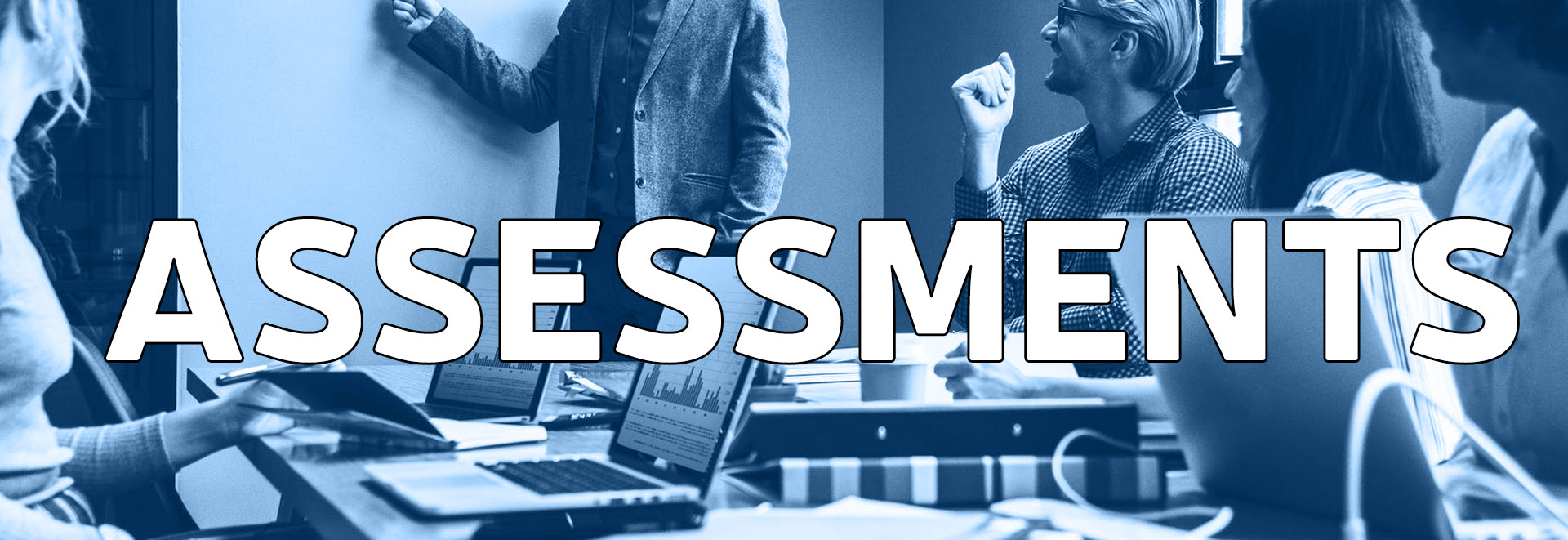
 Get In Touch
Get In Touch 

